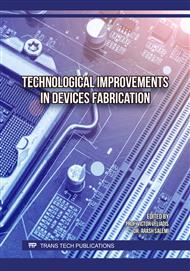[1]
Matsunami, H., "Fundamental research on semiconductor SiC and its applications to power electronics", Proceedings of the Japan Academy. Series B, Physical and biological sciences vol. 96,7 (2020): 235-254
DOI: 10.2183/pjab.96.018
Google Scholar
[2]
Shimbori, A., and Huang, A., "Cost-Effective Formation of Ti/Ni/Ti/Au Ohmic Contacts to n-type SiC Using SiO2 Encapsulation Layer during Phosphorous Implant Activation", 2022 ECS Trans. 109 41
DOI: 10.1149/10908.0041ecst
Google Scholar
[3]
Kuchuk, A. V., Borowicz, P., Wzorek, M., Borysiewicz, M., Ratajczak, R., Golaszewska, K., Kaminska, E., Kladko, V., and Piotrowska, A., "Ni-Based Ohmic Contacts to n-Type 4H-SiC: The Formation Mechanism and Thermal Stability", Advances in Condensed Matter Physics, 2016, 9273702, 26 pages, 2016
DOI: 10.1155/2016/9273702
Google Scholar
[4]
Tsukimoto, S., Onishi, T., Ito, K., and Murakami, M., "Simultaneous Formation of Ohmic Contacts for Both N- and P-Type 4H-Sic Using Nial-Based Contact Materials", MRS Proceedings, vol. 911, p.0911-B11-05, 2006
DOI: 10.1557/PROC-0911-B11-05
Google Scholar
[5]
Vivona, M., Greco, G., Giannazzo, F., Lo Nigro, R., Rascunà, S., Saggio, M., and Roccaforte, F., "Thermal stability of the current transport mechanisms in Ni-based Ohmic contacts on n- and p-implanted 4H-SiC", Semiconductor Science Technology, vol. 29, no. 7, Art. no. 075018, IOP, 2014.
DOI: 10.1088/0268-1242/29/7/075018
Google Scholar
[6]
Ito, K., Onishi, T., Takeda, H. et al. "Simultaneous Formation of Ni/Al Ohmic Contacts to Both n- and p-Type 4H-SiC", J. Electron. Mater. 37, 1674–1680 (2008)
DOI: 10.1007/s11664-008-0525-1
Google Scholar
[7]
Kragh-Buetow, K. C., Okojie, R. S., Lukco, D., and Mohney, S. E., "Characterization of tungsten-nickel simultaneous Ohmic contacts to p- and n-type 4H-SiC", Semiconductor Science Technology, vol. 30, no. 10, Art. no. 105019, IOP, 2015
DOI: 10.1088/0268-1242/30/10/105019
Google Scholar
[8]
Okojie, R. S., and Lukco, D., "Simultaneous ohmic contacts to p- and n-type 4H-SiC by phase segregation annealing of co-sputtered Pt-Ti", J. Appl. Phys. 7 December 2016; 120 (21): 215301
DOI: 10.1063/1.4968572
Google Scholar
[9]
Johnson, B., and Capano, M., "Mechanism of ohmic behavior of Al/Ti contacts to p-type 4H-SiC after annealing", J. Appl. Phys. 15 May 2004; 95 (10): 5616–5620
DOI: 10.1063/1.1707215
Google Scholar
[10]
Buchholt, K., Ghandi, R., Domeij, M., Zetterling, C.-M., Lu, J., Eklund, P., Hultman, L., and Lloyd Spetz, A., "Ohmic contact properties of magnetron sputtered on Ti3SiC2 n- and p-type 4H-silicon carbide", Appl. Phys. Lett. 24 January 2011; 98 (4): 042108
DOI: 10.1063/1.3549198
Google Scholar


